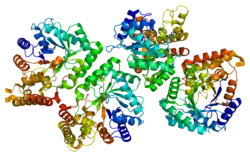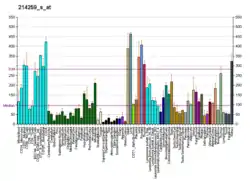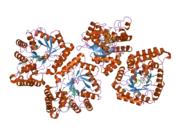AKR7A2
Aflatoxin B1 aldehyde reductase member 2 is an enzyme that in humans is encoded by the AKR7A2 gene.[5][6]
| AKR7A2 | |||||||||||||||||||||||||||||||||||||||||||||||||||
|---|---|---|---|---|---|---|---|---|---|---|---|---|---|---|---|---|---|---|---|---|---|---|---|---|---|---|---|---|---|---|---|---|---|---|---|---|---|---|---|---|---|---|---|---|---|---|---|---|---|---|---|
 | |||||||||||||||||||||||||||||||||||||||||||||||||||
| |||||||||||||||||||||||||||||||||||||||||||||||||||
| Identifiers | |||||||||||||||||||||||||||||||||||||||||||||||||||
| Aliases | AKR7A2, AFAR, AFAR1, AFB1-AR1, AKR7, aldo-keto reductase family 7, member A2, aldo-keto reductase family 7 member A2 | ||||||||||||||||||||||||||||||||||||||||||||||||||
| External IDs | OMIM: 603418 MGI: 107796 HomoloGene: 2737 GeneCards: AKR7A2 | ||||||||||||||||||||||||||||||||||||||||||||||||||
| |||||||||||||||||||||||||||||||||||||||||||||||||||
| |||||||||||||||||||||||||||||||||||||||||||||||||||
| |||||||||||||||||||||||||||||||||||||||||||||||||||
| |||||||||||||||||||||||||||||||||||||||||||||||||||
| |||||||||||||||||||||||||||||||||||||||||||||||||||
| Wikidata | |||||||||||||||||||||||||||||||||||||||||||||||||||
| |||||||||||||||||||||||||||||||||||||||||||||||||||
Function
Aldo-keto reductases, such as AKR7A2, are involved in the detoxification of aldehydes and ketones.[supplied by OMIM][6]
References
- GRCh38: Ensembl release 89: ENSG00000053371 - Ensembl, May 2017
- GRCm38: Ensembl release 89: ENSMUSG00000028743 - Ensembl, May 2017
- "Human PubMed Reference:". National Center for Biotechnology Information, U.S. National Library of Medicine.
- "Mouse PubMed Reference:". National Center for Biotechnology Information, U.S. National Library of Medicine.
- Ireland LS, Harrison DJ, Neal GE, Hayes JD (Aug 1998). "Molecular cloning, expression and catalytic activity of a human AKR7 member of the aldo-keto reductase superfamily: evidence that the major 2-carboxybenzaldehyde reductase from human liver is a homologue of rat aflatoxin B1-aldehyde reductase". Biochem J. 332 (1): 21–34. doi:10.1042/bj3320021. PMC 1219447. PMID 9576847.
- "Entrez Gene: AKR7A2 aldo-keto reductase family 7, member A2 (aflatoxin aldehyde reductase)".
External links
Further reading
- Maruyama K, Sugano S (1994). "Oligo-capping: a simple method to replace the cap structure of eukaryotic mRNAs with oligoribonucleotides". Gene. 138 (1–2): 171–4. doi:10.1016/0378-1119(94)90802-8. PMID 8125298.
- Suzuki Y, Yoshitomo-Nakagawa K, Maruyama K, et al. (1997). "Construction and characterization of a full length-enriched and a 5'-end-enriched cDNA library". Gene. 200 (1–2): 149–56. doi:10.1016/S0378-1119(97)00411-3. PMID 9373149.
- Praml C, Savelyeva L, Perri P, Schwab M (1998). "Cloning of the human aflatoxin B1-aldehyde reductase gene at 1p35-1p36.1 in a region frequently altered in human tumor cells". Cancer Res. 58 (22): 5014–8. PMID 9823300.
- Kelly VP, Sherratt PJ, Crouch DH, Hayes JD (2002). "Novel homodimeric and heterodimeric rat gamma-hydroxybutyrate synthases that associate with the Golgi apparatus define a distinct subclass of aldo-keto reductase 7 family proteins". Biochem. J. 366 (Pt 3): 847–61. doi:10.1042/BJ20020342. PMC 1222835. PMID 12071861.
- Strausberg RL, Feingold EA, Grouse LH, et al. (2003). "Generation and initial analysis of more than 15,000 full-length human and mouse cDNA sequences". Proc. Natl. Acad. Sci. U.S.A. 99 (26): 16899–903. Bibcode:2002PNAS...9916899M. doi:10.1073/pnas.242603899. PMC 139241. PMID 12477932.
- Praml C, Savelyeva L, Schwab M (2003). "Aflatoxin B1 aldehyde reductase (AFAR) genes cluster at 1p35-1p36.1 in a region frequently altered in human tumour cells". Oncogene. 22 (30): 4765–73. doi:10.1038/sj.onc.1206684. PMID 12879023.
- Gerhard DS, Wagner L, Feingold EA, et al. (2004). "The status, quality, and expansion of the NIH full-length cDNA project: the Mammalian Gene Collection (MGC)". Genome Res. 14 (10B): 2121–7. doi:10.1101/gr.2596504. PMC 528928. PMID 15489334.
- Rual JF, Venkatesan K, Hao T, et al. (2005). "Towards a proteome-scale map of the human protein-protein interaction network". Nature. 437 (7062): 1173–8. Bibcode:2005Natur.437.1173R. doi:10.1038/nature04209. PMID 16189514. S2CID 4427026.
- Jordanova A, Irobi J, Thomas FP, et al. (2006). "Disrupted function and axonal distribution of mutant tyrosyl-tRNA synthetase in dominant intermediate Charcot-Marie-Tooth neuropathy". Nat. Genet. 38 (2): 197–202. doi:10.1038/ng1727. PMID 16429158. S2CID 16668375.
- Gregory SG, Barlow KF, McLay KE, et al. (2006). "The DNA sequence and biological annotation of human chromosome 1". Nature. 441 (7091): 315–21. Bibcode:2006Natur.441..315G. doi:10.1038/nature04727. PMID 16710414.
- Lyon RC, Johnston SM, Watson DG, et al. (2007). "Synthesis and catabolism of gamma-hydroxybutyrate in SH-SY5Y human neuroblastoma cells: role of the aldo-keto reductase AKR7A2". J. Biol. Chem. 282 (36): 25986–92. doi:10.1074/jbc.M702465200. PMID 17591773.
This article is issued from Wikipedia. The text is licensed under Creative Commons - Attribution - Sharealike. Additional terms may apply for the media files.





